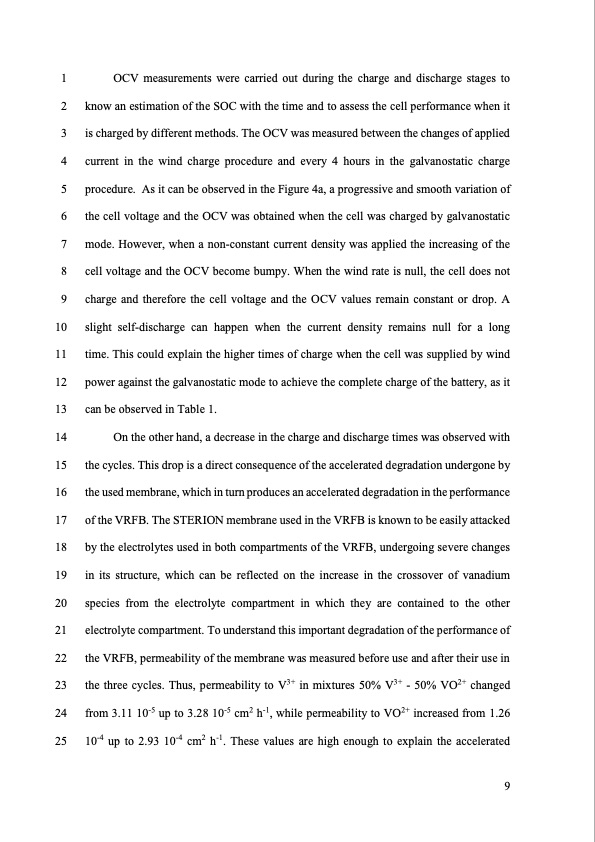
PDF Publication Title:
Text from PDF Page: 009
1 OCV measurements were carried out during the charge and discharge stages to 2 know an estimation of the SOC with the time and to assess the cell performance when it 3 is charged by different methods. The OCV was measured between the changes of applied 4 current in the wind charge procedure and every 4 hours in the galvanostatic charge 5 procedure. As it can be observed in the Figure 4a, a progressive and smooth variation of 6 the cell voltage and the OCV was obtained when the cell was charged by galvanostatic 7 mode. However, when a non-constant current density was applied the increasing of the 8 cell voltage and the OCV become bumpy. When the wind rate is null, the cell does not 9 charge and therefore the cell voltage and the OCV values remain constant or drop. A 10 slight self-discharge can happen when the current density remains null for a long 11 time. This could explain the higher times of charge when the cell was supplied by wind 12 power against the galvanostatic mode to achieve the complete charge of the battery, as it 13 can be observed in Table 1. 14 On the other hand, a decrease in the charge and discharge times was observed with 15 the cycles. This drop is a direct consequence of the accelerated degradation undergone by 16 the used membrane, which in turn produces an accelerated degradation in the performance 17 of the VRFB. The STERION membrane used in the VRFB is known to be easily attacked 18 by the electrolytes used in both compartments of the VRFB, undergoing severe changes 19 in its structure, which can be reflected on the increase in the crossover of vanadium 20 species from the electrolyte compartment in which they are contained to the other 21 electrolyte compartment. To understand this important degradation of the performance of 22 the VRFB, permeability of the membrane was measured before use and after their use in 23 the three cycles. Thus, permeability to V3+ in mixtures 50% V3+ - 50% VO2+ changed 24 from 3.11 10-5 up to 3.28 10-5 cm2 h-1, while permeability to VO2+ increased from 1.26 25 10-4 up to 2.93 10-4 cm2 h-1. These values are high enough to explain the accelerated 9PDF Image | Vanadium Redox Flow Batteries for wind turbines

PDF Search Title:
Vanadium Redox Flow Batteries for wind turbinesOriginal File Name Searched:
wind-turbine-flow-battery-storage.pdfDIY PDF Search: Google It | Yahoo | Bing
Salgenx Redox Flow Battery Technology: Salt water flow battery technology with low cost and great energy density that can be used for power storage and thermal storage. Let us de-risk your production using our license. Our aqueous flow battery is less cost than Tesla Megapack and available faster. Redox flow battery. No membrane needed like with Vanadium, or Bromine. Salgenx flow battery
| CONTACT TEL: 608-238-6001 Email: greg@salgenx.com | RSS | AMP |